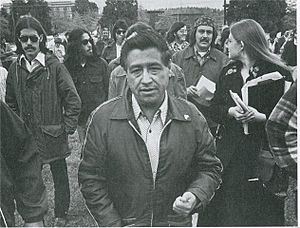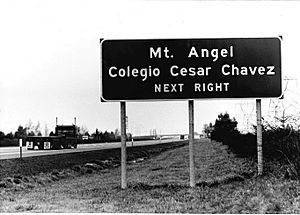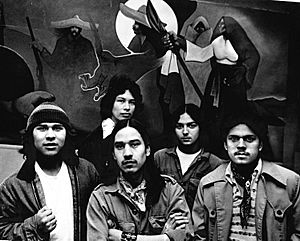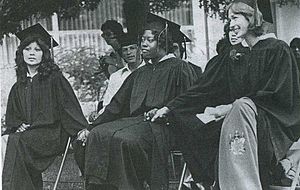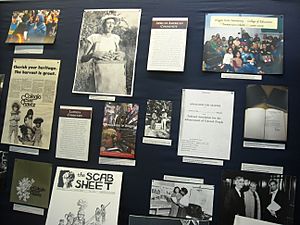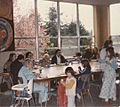Colegio Cesar Chavez facts for kids
Quick facts for kids 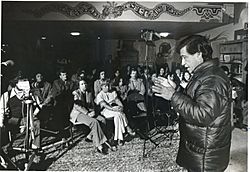
Cesar Chavez lecturing at Colegio Cesar Chavez, 1977
|
|
| Type | Private |
|---|---|
| Active | 1973–1983 |
| Location |
,
,
United States
|
Colegio Cesar Chavez (which means "Cesar Chavez College" in Spanish) was a special kind of college in Mount Angel, Oregon. It was named after César Chávez, a famous Mexican American civil rights leader.
The college opened in 1973 and closed in 1983. It was the first independent four-year college in the United States created for Chicano and Latino students. In 1975, it started working towards full accreditation. By 1977, Colegio gave degrees to 22 students. This was more than the number of Chicano students who graduated that same year from the University of Oregon and Oregon State University combined. Colegio Cesar Chavez was one of the few places named after Cesar Chavez while he was still alive.
Contents
How the College Started
Colegio Cesar Chavez grew from other colleges that had been in Mount Angel, Oregon, for almost 100 years.
Early Schools in Mount Angel
In 1888, a group of Catholic nuns called the Benedictine Sisters started Mt. Angel Academy. This school was first for girls. Later, in 1897, it became a normal school to train women to be teachers. In 1947, it was renamed Mt. Angel Women's College. It began offering a Bachelor of Science degree in elementary education. In 1957, the college started accepting both male and female students and was renamed Mt. Angel College.
Challenges for Mt. Angel College
By 1966, Mt. Angel College had money problems. It received loans to expand, but by 1972, it was in a lot of debt. Student numbers were very low, with only 250 students, and just 37 of them were Mexican American.
Because of these financial issues and low enrollment, the Northwest Association of Schools and Colleges removed the college's accreditation. This meant the college was no longer officially recognized. Most students and staff left.
A New Beginning
A few people, including Sonny Montes and Ernesto Lopez, decided to try and save the college. They wanted to change its focus. On December 12, 1973, Mt. Angel College was renamed Colegio Cesar Chavez.
Colegio aimed to be a four-year college mainly run by Mexican American, or Chicano, staff. It also used a new way of teaching called a "college without walls" program. In 1975, Colegio was granted "candidacy status" for accreditation. This was from the same group that had removed Mt. Angel College's accreditation.
Why the Name Cesar Chavez?
Before choosing "Colegio Cesar Chavez," other names were considered. Cesar Chavez's name was chosen because he was a very important leader in the Chicano movement. He organized boycotts and protests for farm workers in California and the Pacific Northwest. Many Mexican Americans in the Pacific Northwest came there during World War II to work as farm laborers.
José Ángel Gutiérrez, a supporter of the college, said that students got Cesar Chavez's help to deal with the college's debt. He also mentioned that the college staff and students worked hard to keep the college going and get accreditation.
College Without Walls Program
Colegio Cesar Chavez used a special learning model called "El Colegio Sin Paredes," which means "The College Without Walls." This model allowed students to learn by being active in their community. They could control their own education and combine classroom learning with real-world experiences.
This "College Without Walls" idea was started by another group of colleges. It allowed students of different ages to learn together. It also encouraged students, staff, and leaders to work together to create the lessons. They also used different ways to check student progress. Teachers were seen as "facilitators" who helped students learn, rather than just lecturing.
The "La Familia" Approach
Colegio also had a special way of working together called "La Familia," meaning "The Family." Everyone at the college, including staff, leaders, and students, was encouraged to be part of the "family." They all helped make decisions for the college. This meant students needed to be self-motivated and take charge of their own learning.
Learning Areas
Colegio's main education focused on four areas:
- Social Science: This included subjects like how people live in groups (Anthropology), money (Economics), government (Political Science), the mind (Psychology), and society (Sociology).
- Humanities: This covered books (Literature), past events (History), art, ideas (Philosophy), and languages.
- Natural Sciences and Mathematics: This included subjects like biology, chemistry, physics, and math.
- Bilingual Communications: This focused on speaking and writing well in two languages.
Each student needed to complete 15 credit hours in each of these four areas, for a total of 60 credit hours. Students could also get credit for learning they had done before coming to the college.
Leadership at Colegio
Colegio Cesar Chavez had several leaders during its ten years. Each leader faced big challenges.
Early Leaders
- Ernesto Lopez was the first President in 1973, but he only stayed for one year.
- After Lopez, the leadership was split into two co-directors: Sonny Montes for administration and Jose Romero for academics. This was to make the job less overwhelming. Sonny Montes had strong connections in the Chicano Movement. It was during their time that Colegio Cesar Chavez received accreditation candidacy in 1975. Sonny Montes left in 1977 due to personal and money reasons.
- Salvador Ramirez became the top leader in 1977. He had a master's degree in history. During his time, Colegio finished important talks about its debt. He resigned in 1979.
Last President
- Irma Flores Gonzales became president in 1979. She had degrees in education and psychology. She faced the biggest challenges for Colegio, like finding enough money, getting full accreditation by 1981, and getting more students. She was the last president of Colegio.
Campus Buildings
The main building at Colegio Cesar Chavez was a two-story building called Huelga Hall. "Huelga" (pronounced welga) is Spanish for "strike". When it was part of Mt. Angel College, it was called Marmion Hall and was a women's dormitory. Huelga Hall was the center of college life, where most classes were held.
The walls of Huelga Hall were covered with large murals showing Mexican themes. Some were in the style of famous artist Diego Rivera, and others looked like ancient Aztec artwork. There was even a mural of Argentine revolutionary Che Guevara near a fireplace. North of Huelga Hall were two buildings used as dorms for students.
Colegio also owned two houses. Behind Huelga Hall was the Art Building, a two-story Victorian-style farmhouse. It was called Studio San Benito under Mt. Angel College. Under Colegio, it was the Art Building. This building was mostly empty until 1980. Next to the Art House was another two-story house called the Pottery Building. Both the Pottery Building and the Art Building were torn down in the mid-1980s.
Across Main Street from Huelga Hall, Colegio had Guadalupe Hall, named after Our Lady of Guadalupe.
Legacy of Colegio Cesar Chavez
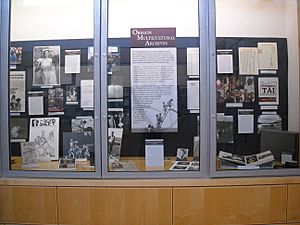
After Colegio Cesar Chavez closed, its buildings were empty for several years. Later, a kind person bought the land and buildings and gave them back to the Benedictine Sisters of Mt. Angel, who had owned them before. Today, the former Colegio campus is used as St. Joseph Shelter, which helps people.
When the Benedictine Sisters got the buildings back, they painted over almost all the murals from the Colegio era. Only one mural remains, called "College Without Walls," created by Daniel Desiga. This mural shows an archway looking out onto a huge strawberry field. The arch is thought to represent the "college without walls" program. The strawberry field likely reminds people of the farm workers, as many students and teachers at Colegio had worked in fields or came from farm working families.
Carlos Maldonado, who wrote the only book about Colegio, said that Colegio was sometimes called "the longest running death in history." He believes studying Colegio can help new ethnic institutions plan better and avoid problems. He noted that Colegio's staff was small and new to running a college. It was also hard to create a strong community feeling because of the "college without walls" program.
Colegio was founded when the Chicano Movement was slowing down and there was less government support for cultural programs. It was also in a small town where many people didn't like the previous college, and some were prejudiced against Mexican Americans. Also, the college was named after Cesar Chavez, whom many local farm owners didn't like.
The Oregon Historical Society says that Colegio Cesar Chavez was a "college-without-walls" where over 100 students took classes. Even though it closed due to money problems, its history shows the success of a community-led movement.
Cesar Chavez's union, the United Farmworkers, is not in Oregon. Instead, the main farm worker union in Oregon is Pineros y Campesinos Unidos del Noroeste. The meetings that led to PCUN's creation were held at Colegio Cesar Chavez. Cipriano Ferrel, PCUN's founder, even attended Colegio Cesar Chavez.
In 2009, Oregon Public Broadcasting discussed Cesar Chavez's connection to Oregon. Joseph Gallegos, an early teacher at Colegio Cesar Chavez, said that in the 1970s and 1980s, "the Colegio was a critical symbol of our presence, the Latino presence here in the state." He added that it helped bring attention to the fact that Latino students were not finishing four-year colleges.
Victor Paredes wrote that Cesar Chavez cared deeply about education. He believed that the opening of Colegio Cesar Chavez was the greatest honor Chavez received during his lifetime.
Jose Romero, a co-founder of Colegio Cesar Chavez, said that they built a Chicano college in a community that was not friendly to Cesar Chavez. He remembered people driving by and shooting holes in their signs. But they succeeded. He feels it was not a lost cause because the buildings are now used as a shelter for farm workers, with training programs.
Notable Alumni
- Cipriano Ferrel, who founded Pineros y Campesinos Unidos del Noroeste (Oregon's farmworker union), earned his bachelor's degree from Colegio Cesar Chavez in 1977.
Images for kids
See also
 In Spanish: Colegio César Chávez para niños
In Spanish: Colegio César Chávez para niños


